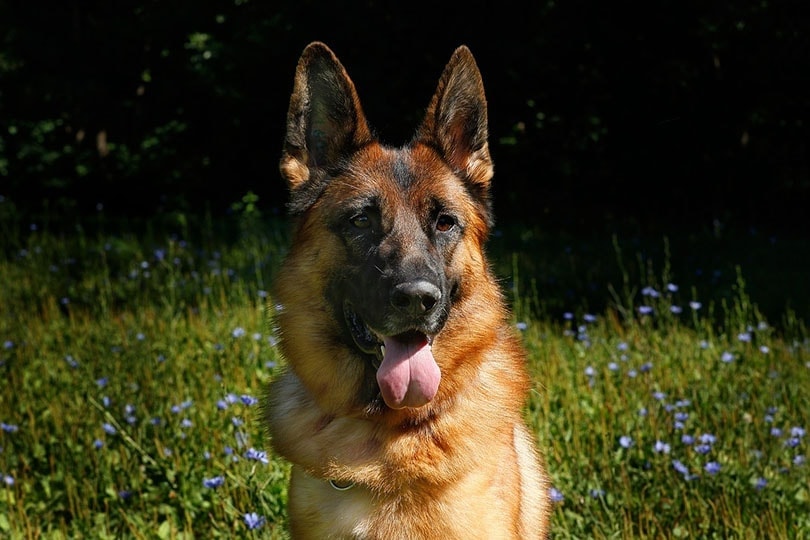Most people are aware that a dog’s tail can be a way for them to communicate, but did you know that your pup also sends signals through their ears? It’s true — the way your dog holds their ears will tell you a great deal about what they’re feeling at any given moment.
However, if you don’t know what you’re looking for when looking at your dog’s ears, you could miss important cues. This could lead to you ignoring signs of aggression or missing signals that your dog is spooked or afraid.
Below, we’ll walk you through what to look for when your dog’s ears start moving.
Ear Positions and What They Mean

There are five basic ear positions, each of which can convey a different meaning. However, while ear position can tell you much about your dog’s emotional state, it’s not foolproof. You should look at both their ear position and other factors, like their overall body language and the situation at hand, to decide what your dog is likely feeling or thinking.
Here are the positions to watch out for, as well as what they may be indicating.
Neutral
This is your dog’s basic, resting state. If your dog’s ears are held in a neutral position, that means they’re comfortable with their surroundings.
Of course, you’ll need to be able to recognize what this means for your dog, as different pups will have different forms of neutral. This will vary from breed to breed as well; for example, a Basset Hound will have a different resting state than a Doberman.
Neutral is (or should be) the most common position your dog’s ears will be in. If it’s not, your pup is likely in a high-stress environment, so you should make some changes on their behalf.
Alert
You’ve likely seen it happen a hundred times: Your dog’s ears are lying there in their neutral position, when all of a sudden, they hear a noise — and those ears shoot straight up in the air.
If your pup pricks up their ears, that means they’re on high alert. They may be suspicious of something they’ve heard, or they may be ready to challenge you to a game of fetch. Regardless, pricked ears are a sign that your dog is completely locked into whatever they’re doing at the time.
Slightly Back
Sometimes your dog will move their ears back slightly while still holding them in a relaxed, calm state. This indicates that your dog is feeling warm and friendly; they’ll often do it when seeking out affection or begging for a treat.
It should be noted that “slightly back” is different from “pinned back.” The difference is largely in how tightly the ears are held back. There shouldn’t be any tension in them at all when they’re in the slightly back position.
Pinned
If your dog’s ears are held tightly to their skull and dropped down slightly, it could mean one of two things. Fortunately, the two are easy to tell apart.
This could mean that your dog is feeling submissive. In that case, it will likely be paired with a tucked tail and exposed belly, or the dog could be slinking around close to the ground.
The other possibility is that your dog’s feeling aggressive or terrified. In either case, their adrenaline will be pumping and they’ll be prone to making rash decisions. Proceed with caution because this is a pup that could easily lash out if you do something that they don’t like.
Changing
This is perhaps the most adorable of all ear positions. Your dog will occasionally cycle between several different positions in a matter of seconds; you may see them raising and lowering each ear in succession while cocking their head from one side to the other.
They do this when they’re confused or trying to figure out a situation. You may have seen your pooch do this while you’re talking to them; it means they’re trying to figure out what, exactly, you’re telling them.
Sometimes, dogs do this when they’re uncomfortable or concerned, though, so take the entire situation into account before you start appreciating the adorableness.
How Reliable Are Ear Position Cues?
While you can tell much about how your dog’s feeling based on how they’re holding their ears, this isn’t an infallible marker. Sometimes your dog will send mixed or false signals, so don’t rely on their ear position exclusively.
Instead, you’ll need to look at the dog’s behavior and body language as a whole while taking the entirety of the situation into account. For example, it’s not impossible for a dog to attack with neutral ears, so if you see raised hackles, bared fangs, and a stiff tail, you should go ahead and ignore what those ears are telling you.
Also, certain breeds have cropped ears, which can affect how expressive they can be. In that case, you’ll need to look at the tail and other body parts to take your cues.

The Ears Have It
Your dog’s ears can give you plenty of information about their mental state, so pay attention to how they hold them during your next interaction. While these cues aren’t 100% reliable, they could be ignored at your peril.
If you spend enough time studying your pup’s body language, you may find yourself able to understand them on a deeper level than you ever thought possible. Even if that doesn’t happen, though, staring at a dog’s ears is sure to cause you to want to scratch them — and everyone wins if that happens.
Want to communicate better with your dog? Check out some of our other posts:
- 11 Types of Dog Barks: What Do They Mean?
- 8 Types of Dog Growls and Their Meanings (with Audio)
- Dog Tail Language: What Your Dog’s Tail Can Tell You
Featured Image Credit: Brent Olson, Unsplash







